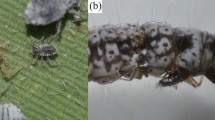Summary
Colonies of the aphidPseudoregma alexanderi produce morphologically-specialized first-instar larvae, termed soldiers, that defend the colony from predators. The environmental cues and physiological mechanisms governing soldier production are currently unknown. Here we present a morphometric study of soldiers and normal first-instar larvae ofP. alexanderi. Several morphological features (fore-leg length and width, hind-leg length, and horn length) plotted against body length display relationship that are similar to a sigmoidal curve. We found further support for an earlier finding that soldiers fall into two size categories, majors and minors, although both types of soldiers appear to follow the same allometry. The patterns of allometry in the soldier-producing aphids are very different from those found in other social insects and do not easily fit into the traditional categorization of allometries. We present two simple alternative models of soldier development as a framework for guiding future studies of the mechanisms of soldier production.
Similar content being viewed by others
References
Aoki, S., 1976. Occurrence of dimorphism in the first instar larvae ofColophina clematis (Homoptera, Aphidoidea).Kontyú 44:130–137.
Aoki, S., 1977.Colophina clematis (Homoptera, Pemphigidae), an aphid species with “soldiers”.Kontyú 45:276–282.
Aoki, S. and M. Miyazaki, 1978. Notes on the pseudoscorpion-like larvae ofPseudoregma alexanderi (Homoptera, Aphidoidea).Kontyú 46:433–438.
Aoki, S., S. Akimoto and S. Yamane, 1981. Observations onPseudoregma alexanderi (Homoptera, Pemphigidae), an aphid species producing pseudoscorpion-like soldier on bamboos.Kontyú 49:355–366.
Dixon, A. F. G., 1985.Aphid Ecology. Blackie & Son Limited, Glasgow.
Lees, A. D., 1966. The control of polymorphism in aphids.Adv. Insect Physiol. 3:207–277.
Oster, G. F. and E. O. Wilson, 1978.Caste and Ecology in the Social Insects. Princeton University Press, Princeton, N. J.
Stern, D. L. and W. A. Foster, 1996a. The evolution of sociality in aphids: a clone's-eye-view. In:Social Competiton and Cooperation in Insects and Arachnids: II Evolution of sociality. (J. Choe and B. Crespi, Eds.), Princeton University Press, Princeton, N.J. in press.
Stern, D. L. and W. A. Foster, 1996b. The evolution of soldiers in aphids.Biological Reviews of the Cambridge Philosophical Society. in press.
Wheeler, D. E., 1991. The developmental basis of worker caste polymorphism in ants.Amer. Nat. 138:1218–1238.
Wilson, E. O., 1971.The Insect Societies. Belknap Press of Harvard University Press, Cambridge, MA.
Author information
Authors and Affiliations
Rights and permissions
About this article
Cite this article
Stern, D.L., Moon, A. & Martinez del Rio, C. Caste allometries in the soldier-producing aphidPseudoregma alexanderi (Hormaphididae: Aphidoidea). Ins. Soc 43, 137–147 (1996). https://doi.org/10.1007/BF01242566
Received:
Revised:
Accepted:
Issue Date:
DOI: https://doi.org/10.1007/BF01242566




